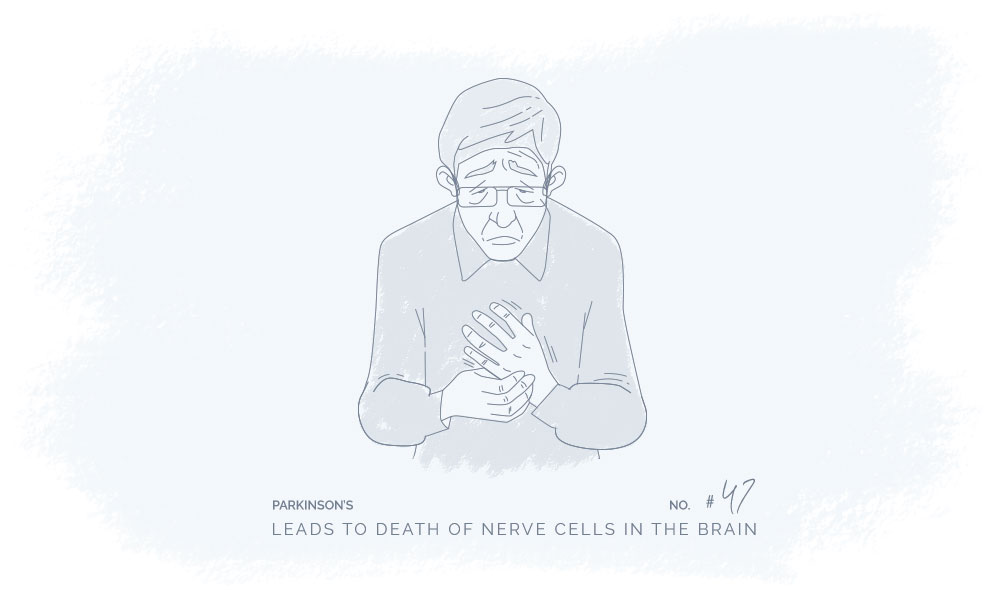Parkinson's Disease
Category
Neurological
REVIEWED BY
Our Biomedical Scientist
Reviewed based on
Literature Review
Last update
November 2020

What is Parkinson's disease
Parkinson’s disease (PD) is a progressive nervous system disorder that leads to the death of nerve cells (i.e. neurons) in the part of the brain called substantia nigra. PD affects movement and is often associated with tremors.1
Symptoms
Signs and symptoms of PD may go unnoticed in the early stages of the disease. However, when the symptoms do appear, they are likely to affect only one side of the body in the beginning before the disease progresses.2
- Tremor
Shaking or tremor - Bradykinesia
Slowed movement causing simple tasks to be difficult and time-consuming - Muscle stiffness
Rigid muscles may occur in all parts of the body - Loss of unconscious movements
Decreased ability to perform an everyday automatic movement (blinking, smiling, etc.) - Changes to speech
May affect the volume, speed, sound, and clearness of talking - Impaired balance and posture
Cause
Certain nerve cells in the brain are affected in PD which can lead to the death or breakdown of these cells. Many symptoms of this disease occur due to the death of neurons that are responsible for the production of dopamine. Decreased dopamine level leads to abnormal brain activity, resulting in impaired movement and other symptoms associated with PD.2
Currently, the exact cause of Parkinson’s disease is unknown. Factors that can increase the risk of PD are:2
- Age
PD is usually developed after the age of 60 - Sex
Men are more likely to develop PD compared to women
- Heredity
Genetics increase the risk of developing PD - Toxin exposure
Continuous exposure to toxins may increase the risk of developing PD
The connection between Cannabinoids & Parkinson's Disease
Studies find that CBD and THC may have great therapeutic potential and may be used to help treat Parkinson’s Disease. CBD and THC are well-known cannabinoids, however, they do not have the same psychoactive effects. THC is psychoactive while CBD does not possess psychoactive effects. According to WHO guidelines, the cannabidiol CBD is generally well tolerated with a good safety profile.
Preclinical data propose that the cannabinoids THC, CBD, THCA, and THV may be beneficial in the treatment of Parkinson’s Disease due to the neuroprotective properties of cannabinoids.2
CBD exhibits anti-inflammatory and antioxidant effects, and both inflammation and oxidative stress are connected to the development of various movement disorders like Parkinson’s disease.3
The literature discussion is an overview of the published results from scientific studies investigating if and how cannabinoids can be beneficial in the treatment of Parkinson’s Disease. The overview will be updated regularly to ensure the newest and most accurate information.
THC and CBD may have neuroprotective properties
It was shown that there is a connection between GPR6 and Parkinson’s disease.4
In human neuroblastoma cells, THC, but not CBD was shown to have neuroprotective properties. PPAR-gamma mediated this neuroprotection.5
In a rat model of Parkinson’s Disease, THCV and CBD showed neuroprotective properties in a CB2-independent way. Mobility was also shown to be improved by THCV in this study.6
In cultured midbrain neurons, it was found that CBD, THCA, and THC exhibited anti-oxidative effects. Furthermore, THCA and THC were found to exert neuroprotective effects.7
In one study, dopamine release was reduced by anandamide via TRPV1 receptors, proposing that they play a role in movement behavior.8
Clinical trials are research studies that examine new treatments and evaluate their effects on human health outcomes.
Cannabinoids showed improvement of symptoms in several clinical trials/studies
In a trial that involved 22 patients, tremor, and bradykinesia (slow movement) were improved when smoking 0.5g cannabis. The effects were observed within 30 minutes of consumption.9
In a patient survey, symptoms were shown to be alleviated when smoking cannabis in 25% of Parkinson’s patients. Of these, almost 50% found that symptoms were facilitated moderately to substantially.10.
In a small-scale trial, psychotic symptoms of Parkinson’s were shown to be decreased by CBD without affecting motor function.11
In a study that involved four patients, insomnia linked to Parkinson’s Disease was immediately reduced by CBD.12
- https://www.mayoclinic.org/diseases-conditions/parkinsons-disease/symptoms-causes/syc-20376055
- https://ghmedical.com/endocannabinoid-system/diseases/parkinsons
- Peres, F.F., Et Al., (2018). ” Cannabidiol as a Promising Strategy to Treat and Prevent Movement Disorders?” .https://www.ncbi.nlm.nih.gov/pmc/articles/PMC5958190/pdf/fphar-09-00482.pdf
- Laun, A.S., Song, Z.H., (2017). ”GPR3 and GPR6, novel molecular targets for cannabidiol”. https://www.sciencedirect.com/science/article/abs/pii/S0006291X17310744?via%3Dihub
- Caroll, C.B., Et Al., (2012). ”Δ⁹-tetrahydrocannabinol (Δ⁹-THC) exerts a direct neuroprotective effect in a human cell culture model of Parkinson’s disease”. https://pubmed.ncbi.nlm.nih.gov/22236282/
- Garcia, C., (2011). “Symptom-relieving and neuroprotective effects of the phytocannabinoid Δ9-THCV in animal models of Parkinson’s disease”. https://www.ncbi.nlm.nih.gov/pmc/articles/PMC3165958/
- Moldozio, R., Et Al., (2012). “Effects of cannabinoids Δ(9)-tetrahydrocannabinol, Δ(9)-tetrahydrocannabinolic acid and cannabidiol in MPP+ affected murine mesencephalic cultures”. https://pubmed.ncbi.nlm.nih.gov/22571976/
- Lago, E., Et Al., (2004). “Involvement of vanilloid-like receptors in the effects of anandamide on motor behavior and nigrostriatal dopaminergic activity: in vivo and in vitro evidence”. https://pubmed.ncbi.nlm.nih.gov/15064146/
- Lotan, I., Et Al., (2014). “Cannabis (medical marijuana) treatment for motor and non-motor symptoms of Parkinson disease: an open-label observational study”. https://pubmed.ncbi.nlm.nih.gov/24614667/
- Venderova, K., Et Al., (2004). “Survey on cannabis use in Parkinson’s disease: subjective improvement of motor symptoms”. https://pubmed.ncbi.nlm.nih.gov/15372606/
- Zuardi, A.W., Et Al., (2009). ”Cannabidiol for the treatment of psychosis in Parkinson’s disease”. https://pubmed.ncbi.nlm.nih.gov/18801821/
- Chagas, M.H.N., Et Al., (2014). ”Cannabidiol can improve complex sleep-related behaviours associated with rapid eye movement sleep behaviour disorder in Parkinson’s disease patients: a case series”. https://pubmed.ncbi.nlm.nih.gov/24845114/
CANNABINOIDS & RECEPTORS
Below you find the plant cannabinoids, cannabinoid receptors, and endocannabinoids that are associated with the potential therapy.
- CBD
- THC
- THCV
- THCA
- CB1
- CB2
- TRPV1
- PPARγ,
- PPARa
- GPR6
- GPR12
- Anandamide
- OEA
- 2AG
- PEA
If you have any further information relevant to the connection between Parkinson’s Disease and cannabinoids or find any of the information inaccurate, outdated or incomplete please contact us here.

